11 Boho Kitchen & Living Room Combo Ideas for Cozy Style
I’ve always loved how the bohemian style celebrates creativity, comfort, and freedom. When you blend that with an open concept home — connecting the kitchen and living room — magic happens.
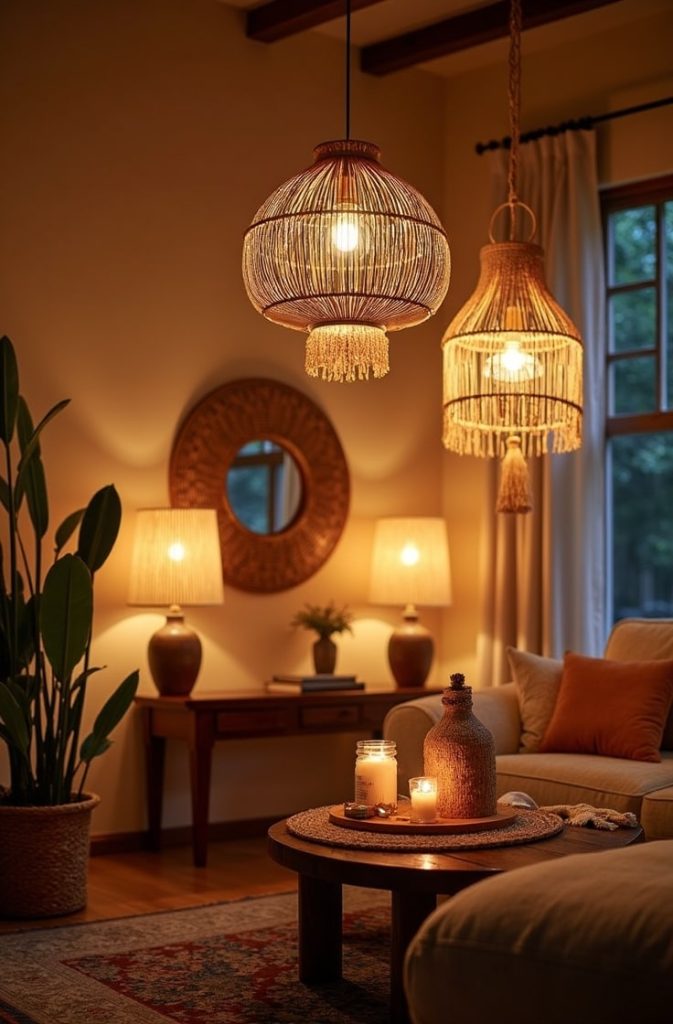
A boho kitchen and living room combo feels relaxed yet intentional, rich with texture and personality. Think natural wood tones, woven accents, earthy colors, and artful clutter that tells a story. Whether you’re decorating a small apartment or a spacious home, this aesthetic helps you create flow, warmth, and charm throughout your space.
Let me walk you through eleven bohemian kitchen and living room design ideas that inspire connection, creativity, and cozy living.
Table of Contents
- 1. Create an Earthy Boho Flow Between Spaces
- 2. Mix Rustic and Modern Elements for Balance
- 3. Highlight Natural Materials and Organic Textures
- 4. Define Spaces with Rugs and Lighting
- 5. Play with Eclectic Furniture and Decor
- 6. Introduce Plants for Life and Color
- 7. Add Warm Lighting for a Cozy Atmosphere
- 8. Use Open Shelving to Blend Function and Style
- 9. Incorporate Global-Inspired Accents
- 10. Choose Statement Art to Unify the Space
- 11. Personalize Your Boho Combo with Meaningful Touches
- Conclusion
1. Create an Earthy Boho Flow Between Spaces
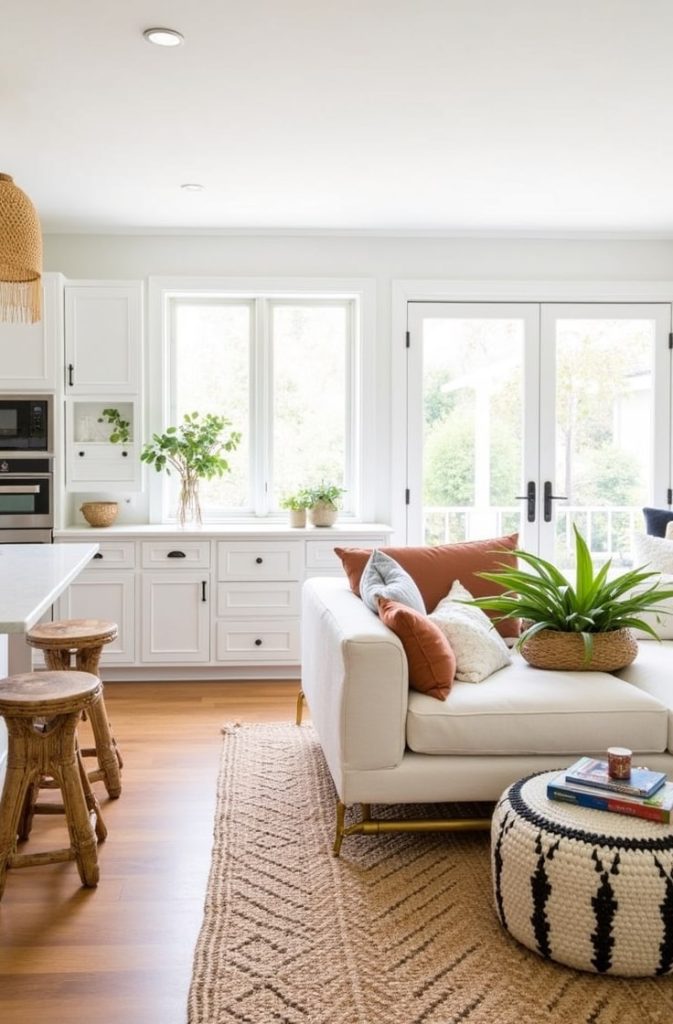
When merging two rooms, continuity is key. I start by grounding the space with earthy boho colors — warm whites, clay, olive green, and soft terracotta. Using a similar color palette in both rooms makes the transition effortless.
Add woven pendant lights over the kitchen island and echo that texture with rattan furniture or baskets in the living room. This natural repetition ties the rooms together. I also like placing a boho area rug that stretches slightly between the two zones. It defines the spaces without closing them off, keeping everything cohesive and calm.
2. Mix Rustic and Modern Elements for Balance

A well-designed boho kitchen living room combo blends styles with ease. I love pairing modern cabinets and open shelving with rustic wood beams or reclaimed furniture. The trick is balance — not everything needs to be perfectly matched. Let your materials contrast naturally.
Use matte black hardware in the kitchen for modern flair, and complement it with an antique wooden coffee table in the living room. Add boho wall art featuring natural tones or abstract patterns to bridge the look. The mix of old and new gives the space a lived-in, soulful vibe.
3. Highlight Natural Materials and Organic Textures
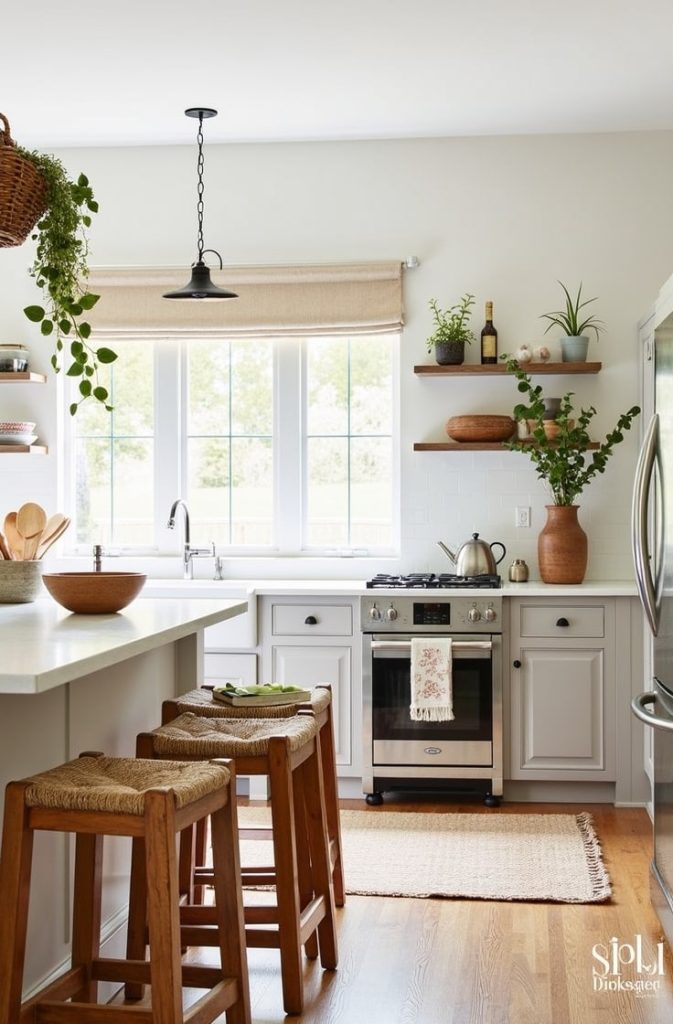
The heart of bohemian interior design lies in tactile beauty. I always recommend incorporating materials that feel earthy and real. Think jute rugs, linen throws, wooden stools, and terracotta planters. These textures soften the lines of modern kitchens and add warmth to your living area.
You can repeat textures intentionally — like woven bar stools at the counter and macramé wall hangings in the lounge. Layering these organic touches gives your home that casual, sun-kissed energy the boho style is known for.
4. Define Spaces with Rugs and Lighting
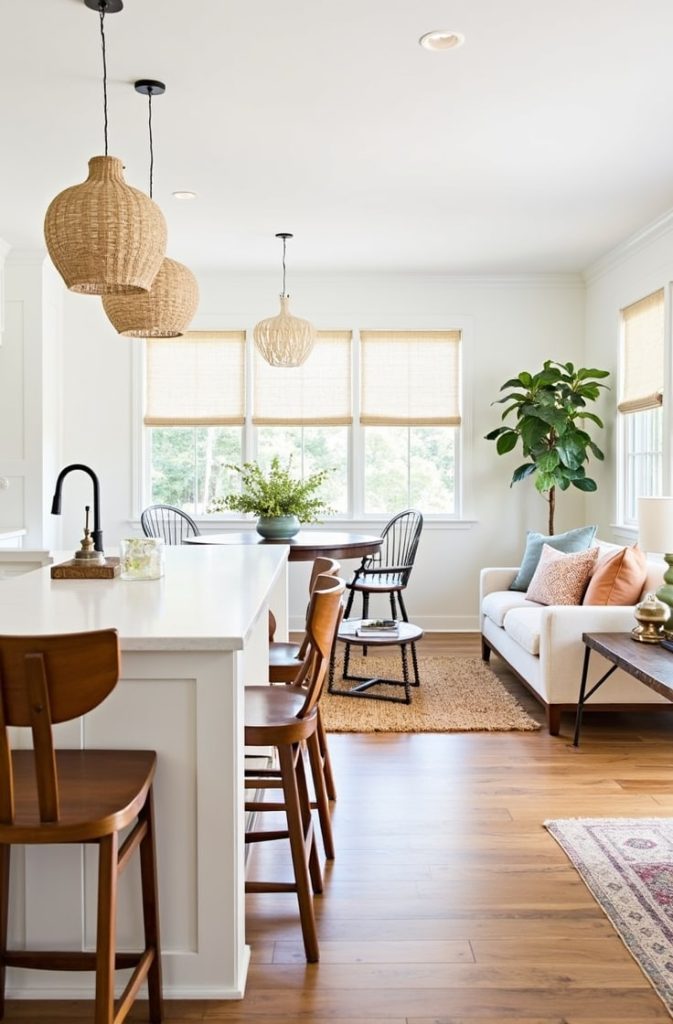
Open layouts can blur boundaries, but smart design keeps them harmonious. I love using boho patterned rugs to separate the kitchen from the living zone subtly. A warm-toned rug under the sofa complements a neutral runner in the kitchen, creating visual rhythm.
Lighting is another subtle divider — pendant lamps above the island and soft, woven floor lamps by the couch. The combination adds intimacy without interrupting flow. This approach keeps both areas distinct yet unified through color and light.
5. Play with Eclectic Furniture and Decor
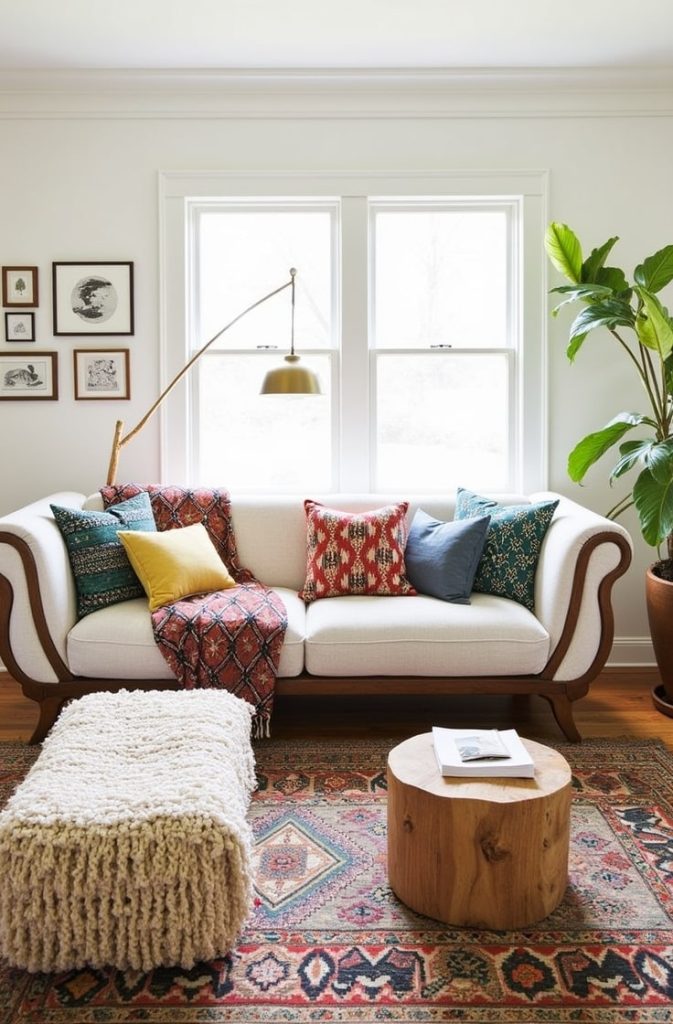
Boho decor thrives on individuality. I never shy away from mixing furniture styles — maybe a vintage armchair beside a modern sofa, or rustic stools under sleek counters.
Each piece tells a story. Choose boho-style cushions, fringed throws, or patterned poufs to tie everything together. Don’t be afraid to let imperfections shine — uneven wood, textured fabrics, or aged finishes make the space authentic.
The result feels curated, not cluttered, full of charm and effortless character.
6. Introduce Plants for Life and Color

A boho space without greenery feels incomplete to me. Plants bring balance, texture, and vitality to open spaces.
Use hanging plants in the kitchen corner, trailing pothos from open shelves, and large floor plants beside your sofa. Mix ceramic, rattan, and clay planters for a layered, natural look.
Greenery visually connects the two rooms, breathing life into every corner. It’s such a simple yet powerful way to make your boho kitchen and living room combo feel fresh and organic.
7. Add Warm Lighting for a Cozy Atmosphere

Lighting transforms mood instantly. I love using warm, ambient light to make a boho combo feel inviting. Opt for rattan pendants, woven sconces, or macramé light covers that cast beautiful shadows.
In the living area, go for soft, glowing lamps and string lights for a touch of whimsy. When the light bounces off earthy tones and natural textures, the whole space glows. It’s cozy, romantic, and distinctly bohemian.
8. Use Open Shelving to Blend Function and Style

Open shelving makes transitions between the kitchen and living area smoother. Instead of bulky cabinets, I install floating wood shelves to display both dishes and decor.
It’s the perfect chance to mix practical items — mugs, jars — with decorative touches like ceramic vases, framed art, and woven baskets.
Continue the look into the living room with shelves holding books and plants. The result? A seamless blend of function and beauty that reflects everyday life with artistic flair.
9. Incorporate Global-Inspired Accents
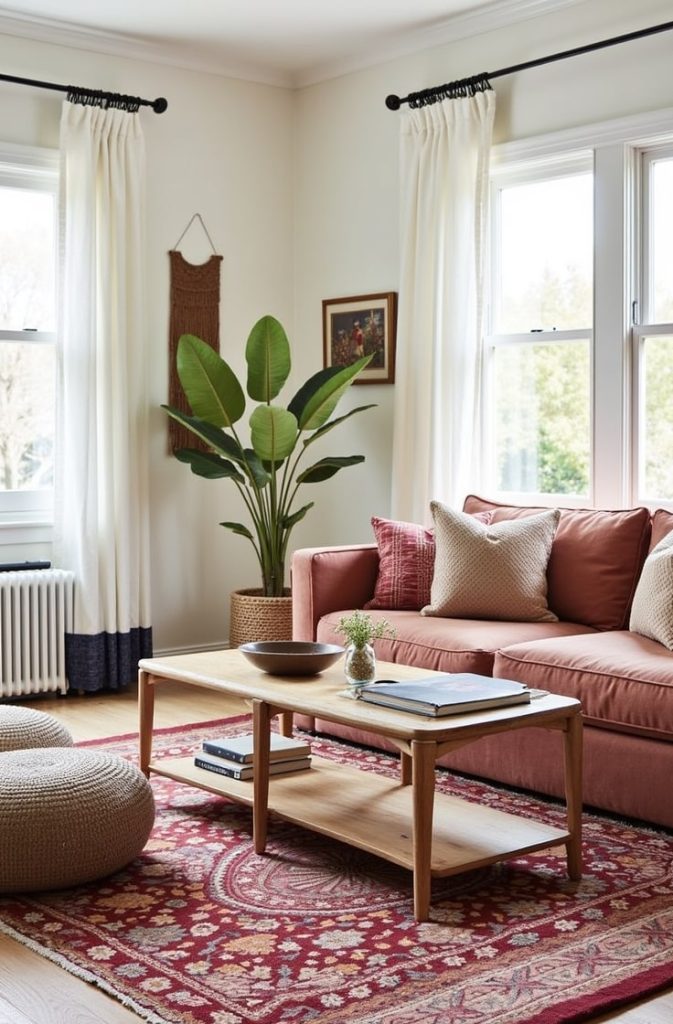
I adore how global boho decor adds personality to open spaces. Handcrafted pieces from different cultures — Moroccan poufs, Turkish rugs, or Indian block-printed cushions — instantly make your home feel collected, not decorated.
Hang woven wall art or colorful textiles near the kitchen, then mirror those hues in the living room. It’s a storytelling approach that celebrates travel, heritage, and artistry, turning your home into a warm cultural tapestry.
10. Choose Statement Art to Unify the Space

Art is the emotional link between rooms. I like using large-scale boho wall art — perhaps an abstract canvas or woven tapestry — that bridges both spaces visually. Hang it where both rooms can enjoy it, such as above the dining area or on the wall facing the living room.
The artwork’s colors and textures act as a common thread, connecting the kitchen’s energy with the living room’s calm. Even a single piece can tie everything together beautifully.
11. Personalize Your Boho Combo with Meaningful Touches
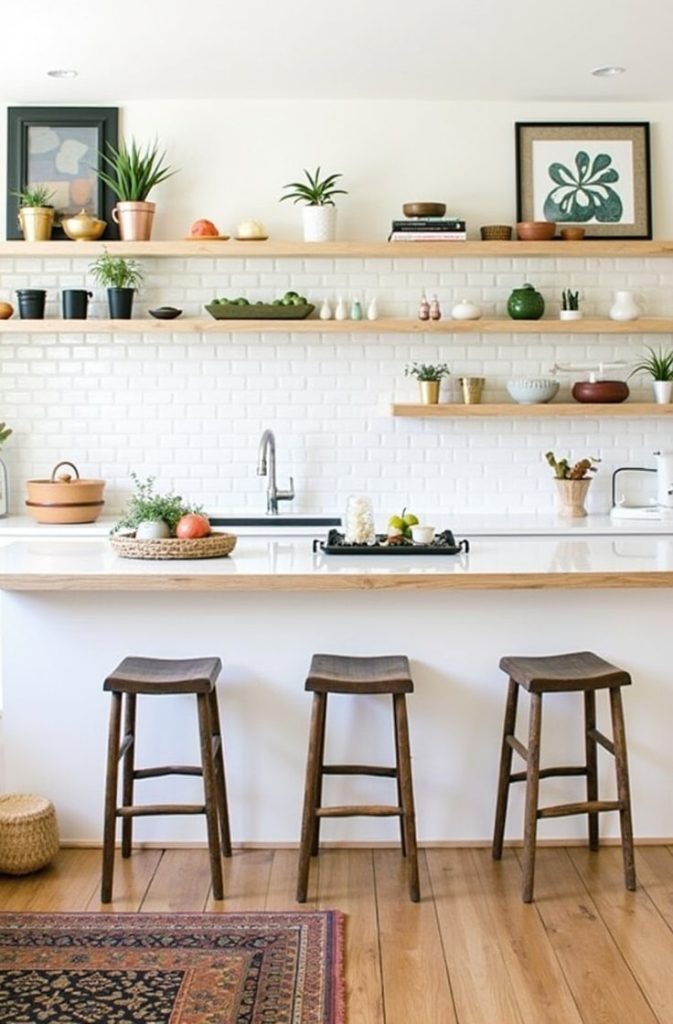
The best boho interiors tell your story. Add items that mean something — framed photos, handmade pottery, travel finds, or vintage treasures. I love mixing family heirlooms with new finds to keep things personal and layered.
Display cookbooks beside crystals, candles next to art prints. The charm lies in how it feels lived-in, not staged. Your boho kitchen and living room combo becomes an extension of your personality — relaxed, eclectic, and full of soul.
Conclusion
Blending your kitchen and living room in a boho style is more than a design choice — it’s a lifestyle statement. It celebrates comfort, creativity, and connection.
From earthy tones and natural materials to global-inspired art and handcrafted decor, every detail contributes to an atmosphere that feels genuine and grounded. Let your imagination guide you. Don’t aim for perfection — aim for personality.
Your home should reflect who you are and what you love. Start with one idea that speaks to your spirit and build from there. Before long, you’ll have a space that feels effortless, welcoming, and uniquely yours.

Emily Harper is a kitchen decor expert and interior designer with a passion for creating stylish, functional spaces. As a busy mom, she understands the importance of a kitchen that works for both family life and design. With 6 years of experience, Emily specializes in transforming kitchens into inviting, practical spaces. She’s known for her ability to blend trends with everyday needs, helping families create kitchens that feel like the heart of the home.






